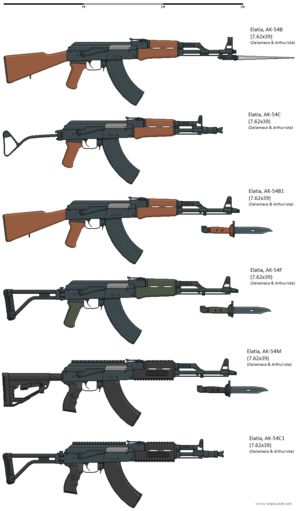AK-54
 AK-54 | |
| Place of origin | |
| Service history | |
| In service | 1955 - present |
| Used by | Elatian Army |
| Production history | |
| Designed | 1953 |
| Produced | 1954 - present |
| Variants | See Variants |
| Specifications | |
| Weight | 3.7kg |
| Length | 882mm |
| Barrel length | 414mm |
| Cartridge | 7.62x39mm |
| Action | Gas operated, rotating bolt |
| Rate of fire | Semi-automatic |
| Effective firing range | 400m |
| Feed system | 30-rounds box magazine |
| Sights | adjustable iron sight |
The AK-54 ('Automata Karabeno 1954') is a model of combat rifle employed by Elatia. Having entered service in 1955, it continues to be used as the Elatian Army's standard issue service rifle.
Origin
Elatian infantry squads entered into the Belfro-Elatian War armed mainly with bolt-action rifles, submachine guns and light machine guns. As with many other armies during this period, they discovered that most firefights took place within 200m, and that the volume of suppressive firepower is often the decisive factor in winning engagements. Subsequent to the war, many younger officers advocated the wholesale introduction of assault rifles. This was resisted by the more conservative senior officers, who continued to see value in long-barreled infantry weapons. In 1948, it was decided that the K-48 semi-automatic carbine, chambered for the 7.62x39mm cartridge, would become the new service rifle of the Elatian military.
However, assault rifles were introduced into the Elatian Army through the back door, by being framed as a replacement for submachine guns. It was in this context that the later-ubiquitous Suvarovan design was copied. The Elatian infantry squad of the 1950's consisted of ten people, with one magazine-fed light machine gun chambered in the 7.65x53mm cartridge, two AK-54 assault rifles, and six K-48 carbines. It was not until the late-60's that assault rifles finally completely supplanted the semi-automatic carbine as the main infantry weapon.
Design
The original AK-54 had a milled receiver, which took a skilled machinist considerable time to fabricate. Its main distinguishing feature was its permanently-attached folding spike bayonet.
The definitive AK-54B of 1960 saw the introduction of a stamped receiver. It is slightly thicker than average (1.35mm vs 1mm), resulting in increased structural rigidity at the cost of some weight increase. Many of the features of the original milled receiver rifle were also retained, including the pistol grip, the shape of the buttstock (although it is hollowed to a greater degree to reduce weight) and the hooded front sight. Around the mid-70's, Elatian manufacturers gradually dropped the folding bayonet in favour of a modern combat knife bayonet.
Elatian small arms manufacturing after the Belfro-Elatian War was decentralised, a decision made in order to mitigate the risk of strategic bombing or nuclear attack on major cities upon weapons production. Whilst quality control was strictly enforced, and whilst all parts must be mutually interchangeable, these provincial fabricators were permitted to experiment with the designs of various parts. Accordingly, there exists many variations in terms of the configuration of the front sight (hooded or open), the shape of the foregrip and pistol grip, the shape of the fixed wooden buttstock, and even different types of folding stocks (underfolder, side-folder or wire-hanger). Some factories in more remote parts of the country, which had access to experienced machinists but not modern stamping technology, made milled-receiver guns well into the 1980's.
The AK-54F variant entered service in 1993 and is gradually supplanting older versions of the weapon in frontline service. The -F model replaced the wooden furniture with green synthetic and harmonised the foresight to the open type. A new, standardised folding buttstock is introduced, replacing the wooden fixed buttstock and the underfolder. The tube metal parts of the buttstock are covered with a sheet of plastic in order to enhance user comfort in very cold environments. A polymer magazine was introduced, although the older steel magazine remains far more common. Optics are also increasingly common amongst frontline infantrymen, installed using the scope mount located to the side of the receiver. These include the Kashtan scope, the Kobra red-dot sight, as well as various night vision scopes.
The AK-54C is the compact version of the rifle, with its barrel reduced to 305mm in length. It was intended for rear-area troops and vehicle crew as a self-defence weapon, although it has also been popular with special forces personnel.
AK-54M
The AK-54M is treated within the Elatian military-industrial complex as a version of the AK-54. However, it is effectively an entirely new gun, based upon a licensed version of the Suvarovan AK-15. Its main improvement over the older iterations of the rifle is its use of accessory rails for the mounting of optics and other useful devices.
The AK-54M has entered service with elite units of the Elatian military and security apparatus and as of 2021 is slowly percolating down the food chain.
AK-54S
The AK-54S Special Applications Carbine was introduced in the early-90's, primarily intended for use by special forces personnel in close assault missions. The carbine is chambered in the 9x39mm, a necked-up version of the standard service cartridge which combines the virtues of high stopping-power and armour piercing capability in a subsonic package for ease of integration with suppressors. These advantages come at the cost of the reduction of the weapon's effective range to within 200m.

